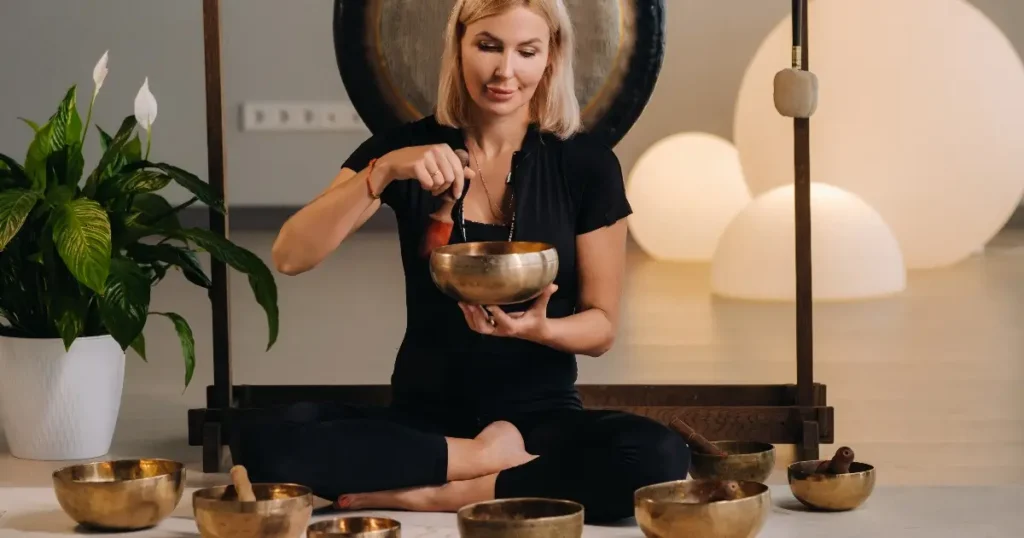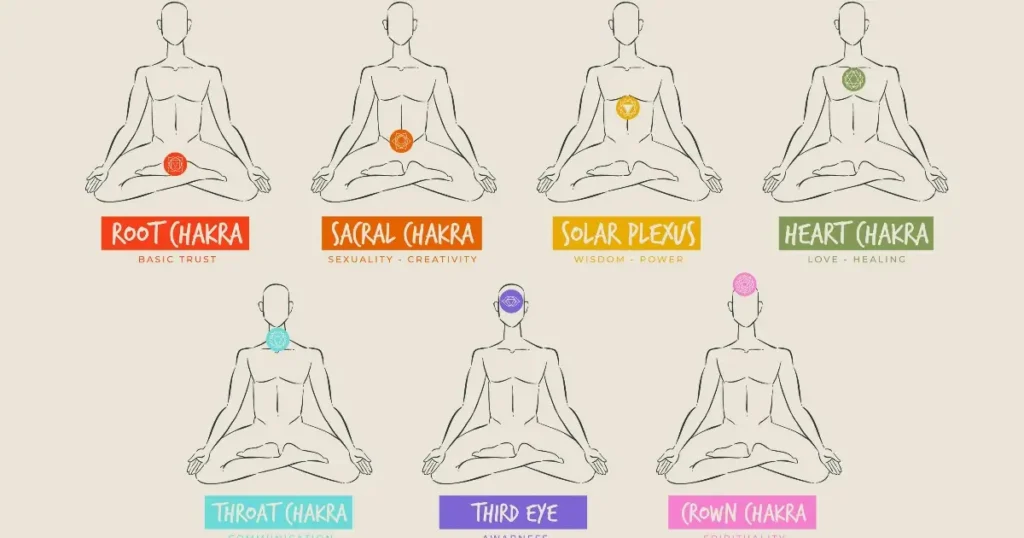Mantra Meditation: Finding Harmony in the Chants

Mantra meditation is a form of meditation that involves repeating a particular sound, word, or phrase silently or aloud. The term ‘mantra’ finds its origin in the ancient Sanskrit language. ‘Man’ denotes mind and ‘tra’ signifies tool or instrument.
The mantra serves as a focal point for the mind, allowing it to settle into a state of deep concentration and inner peace. This practice has roots in ancient traditions like Hinduism and Buddhism and is believed to have numerous benefits,
such as reducing stress, enhancing mindfulness, and promoting relaxation. By continuously repeating the mantra, practitioners aim to quiet the mind, cultivate self-awareness, and access a sense of spiritual connection or tranquility.
In this blog post, we explain mantra meditation in detail and give you a step-by-step guide on how to practice it.
Understanding the Concept of Mantra Meditation

At its core, mantra meditation is a form of focused meditation that harnesses the power of repetition and sound vibration.
It involves choosing a specific word, phrase, or sound, known as a mantra, and mentally repeating or chanting it during your meditation session.
The mantra serves as a focal point for your attention, helping to clear your mind and heighten your awareness.
As you concentrate on the rhythm and vibrations of the mantra, your mind gradually transitions from a state of activity to one of calm and stillness.
This journey towards tranquility creates a space for introspection, self-awareness, and inner peace.
It’s important to note that mantra meditation is not about suppressing your thoughts but rather providing them with a gentle guide back to the mantra each time they stray.
This cyclical process forms the heart of mantra meditation, leading you towards a state of relaxed alertness and profound inner calm.
The beauty of mantra meditation lies in its simplicity and flexibility, making it accessible to both beginners and seasoned meditators.
With the right intention and consistent practice, you can unlock the transformative power of mantra meditation.
The Power and Significance of Mantras

The magic of mantra meditation lies in the transformative power of the mantras themselves. These aren’t just ordinary words or sounds.
They’re loaded with vibrational energy and deep significance that can shift your consciousness and shape your meditation experience.
Mantras can be in any tongue, but Sanskrit is often chosen for its unique vibrational frequencies, which are believed to resonate with specific energy hubs within the body.
Each mantra you chant or mentally repeat carries a distinct meaning and intention, and these can vary widely.
Some might be employed to foster peace and tranquility, while others might serve to channel expressions of love, gratitude, or even strength.
For example, repeating ‘Om Shanti Shanti Shanti’ sends out vibrations of peace, while ‘Om Mani Padme Hum’ is associated with compassion and wisdom.
Om Shanti” typically includes the repetition of “Shanti” three times.
Each “Shanti” represents peace in three dimensions: physical, mental, and spiritual.
So, it’s often recited as “Om Shanti Shanti Shanti” to invoke peace in all aspects of life.
The idea is to select a mantra that aligns with your personal intention for meditation, setting a resonant frequency that vibrates through your being and amplifies your meditative experience.
With each repetition, the mantra reverberates within you, quieting the mind and drawing you closer to your center.
It’s more than a chant—it’s an energetic expression of your innermost desires and intent.
Selecting Your Mantra

Your mantra is more than just a string of words – it’s an embodiment of your intention for your meditation practice.
As such, selecting a mantra that aligns with your personal intentions and resonates with you is key.
Your mantra could be a simple word or phrase, like ‘serenity’, or a meaningful Sanskrit chant such as ‘Om Shanti Shanti Shanti’, which invokes peace.
English phrases can be equally powerful, like ‘I am present’ or ‘I am enough’. Whatever your choice, it should be something that feels authentic to you.
Remember, there’s no ‘one size fits all’ when it comes to mantras. Experiment with different phrases and observe how they make you feel.
Be patient, and give yourself the freedom to change your mantra as your intentions and feelings evolve.
Just as your yoga practice may vary from day to day, so too might your mantra.
The mantra is not just about the words, but about the energy they help you cultivate.
So, choose wisely, and let your mantra guide you towards a fulfilling and meaningful meditation experience.
Mantra Ideas

Mantras hold the power to center the mind, uplift the spirit, and cultivate a sense of peace and purpose within.
Here are various mantras categorized by their themes, each carrying unique vibrations to aid in meditation and daily affirmations.
Explore these powerful phrases to find resonance and guidance on your journey towards mindfulness and self-discovery.
| Universal Mantras | Meaning |
|---|---|
| “Om Shanti” | Peace |
| “So Hum” | I am that |
| “Sat Nam” | Truth is my identity |
| “Om Mani Padme Hum” | Compassion and enlightenment |
| Self-Affirmation Mantras |
|---|
| “I am enough, just as I am.” |
| “I am worthy of love and acceptance.” |
| “I embrace my worthiness and value.” |
| “I accept myself completely and unconditionally.” |
| “I am whole and complete.” |
| Empowering Mantras |
|---|
| “If you believe in yourself, anything is possible.” |
| “I am capable of achieving greatness.” |
| “Strength and courage flow through me.” |
| “I trust in my inner wisdom.” |
| “I am the architect of my own destiny.” |
| Mindfulness and Present Moment Mantras |
|---|
| “I am present, I am here.” |
| “Peace begins with me.” |
| “In this moment, I breathe and let go.” |
| “I embrace the beauty of each moment.” |
| “Love and light flow through me.” |
| Gratitude and Positivity Mantras |
|---|
| “I am grateful for all that I have.” |
| “I attract positivity and abundance.” |
| “My heart is open to receive blessings.” |
| “I radiate love and joy to the world.” |
| “Every challenge is an opportunity for growth.” |
Preparing for Mantra Meditation

As you gear up to dive into the soothing world of mantra meditation, there are a few preliminary steps to set the stage for a fruitful practice.
First, scout for a serene spot that promises solitude, free from interruptions and disruptions.
Whether it’s a cozy corner in your room or a tranquil spot in your garden, the environment should encourage a sense of calm and tranquility.
Position yourself comfortably on a chair, cushion, or directly on the floor, ensuring your back is straight, yet relaxed.
Equally important is mental preparation. Welcome the practice with a sense of openness and curiosity, devoid of any judgment or preconceived notions.
This is not a battlefield to conquer your thoughts or suppress them.
Rather, think of it as a space to gently channel your mental energy towards the mantra, guiding it back each time it strays away.
Establishing a routine can do wonders for your practice.
Consistency not only helps in building a habit but also primes your mind and body for meditation.
Try to meditate at the same spot and the same time daily to cultivate a rhythm.
This preparatory phase is a critical step, setting the tone for your mantra meditation journey.
Step-By-Step Guide to Mantra Meditation

Embarking on your mantra meditation journey is simple and straightforward:
| Step 1 | To initiate the process, find a comfortable position where your body can relax but your mind can stay alert. |
| Step 2 | With your eyes closed, allow yourself to take a few deep, calming breaths to prime your body and mind for meditation. |
| Step 3 | Once you’re settled, gently start to introduce your chosen mantra into your consciousness. |
| step 4 | You can decide whether to chant it silently in your mind or to whisper it aloud. |
| Step 5 | Let the vibrations of the mantra fill your being as you continue to repeat it, focusing all your attention on its sound and resonance. |
| Step 6 | If you find your thoughts straying away from the mantra, don’t worry—that’s completely natural. |
| Step 7 | The key is to gently and without judgment steer your focus back to the mantra, accepting this as part of the process. |
| Step 8 | Aim to sustain your mantra meditation for a determined duration, ideally starting with about 5 minutes and gradually extending this time as your practice deepens. |
| Step 9 | After your meditation, instead of rushing back to the hustle and bustle of your day, give yourself a few quiet moments to bask in the calm and centered state you’ve cultivated. |
Scientifically-Proven Benefits of Mantra Meditation

In addition to the spiritual growth and inner peace mantra meditation provides, it also comes with a plethora of scientifically validated advantages.
This ancient practice is more than just a spiritual endeavor, it’s a boon for your physical and mental health as well.
Research has demonstrated that incorporating mantra meditation into your daily routine can significantly alleviate stress and anxiety.
It has the power to center your mind, boosting concentration levels and enhancing your cognitive abilities.
Meditating with mantras has also been linked to cardiovascular benefits, such as decreased heart rate and lower blood pressure, promoting overall heart health.
Even your body’s defense mechanism can get a boost from this practice, as it’s found to strengthen the immune function.
The repetitive nature of mantras creates an environment conducive for mindfulness, fostering a deep sense of self-awareness.
This improved self-awareness can lead to better mental health and a more balanced emotional state.
Remember, the effects of mantra meditation are not just spiritual, but holistic, positively impacting various facets of your health and well-being.
The proof is in the research – mantra meditation can truly be a game-changer for your health and happiness.
Final Thoughts

In essence, mantra meditation offers a holistic approach to wellness, grounding you in the present moment while imparting peace, mindfulness, and a sense of inner equilibrium.
The potent blend of sound, repetition, and intentionality creates a powerful meditative tool that reaches far beyond the realms of spiritual growth, extending its impact into physical and mental well-being.
Remember, there’s no one-size-fits-all with mantra meditation.
It’s a deeply personal practice that evolves with your personal intentions and journey.
Be patient with yourself, maintain consistency, and honor your experience at every step.
No matter where you are on your meditation journey, whether you’re a beginner or an experienced practitioner, mantra meditation can be a transformative practice to incorporate into your daily routine.
Trust the process, let your mantra guide you, and embark on a journey towards a more mindful, balanced, and tranquil state of being.

















